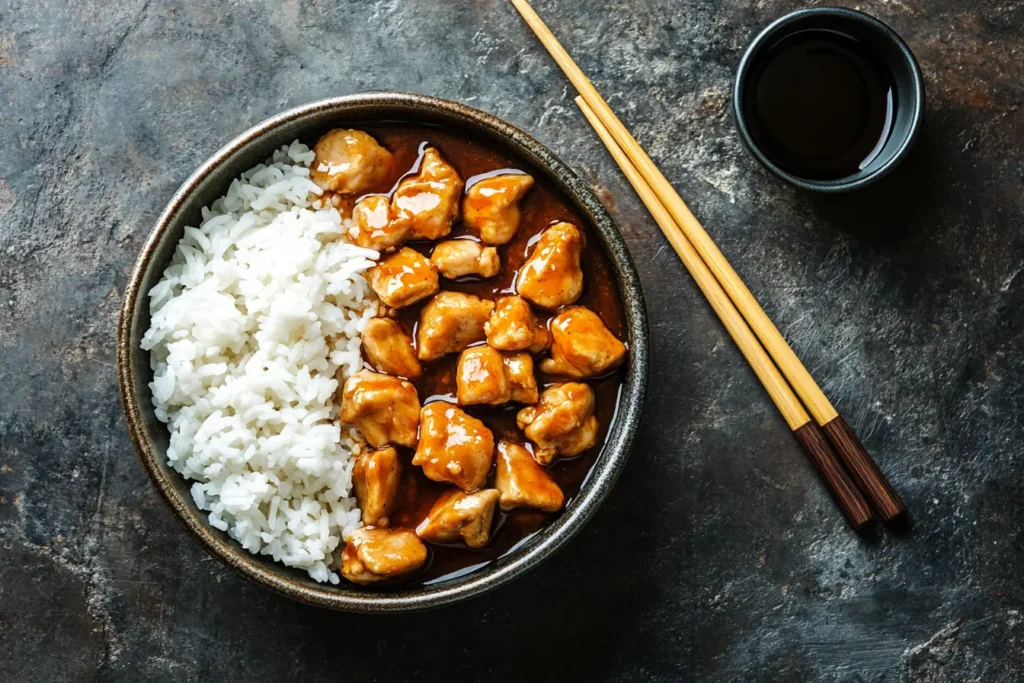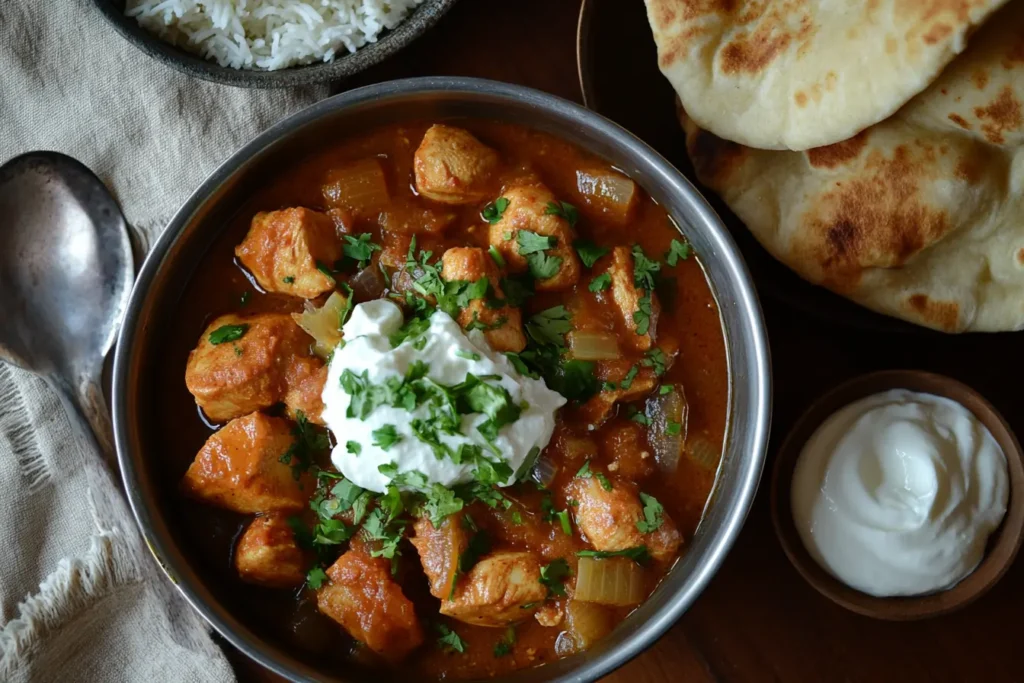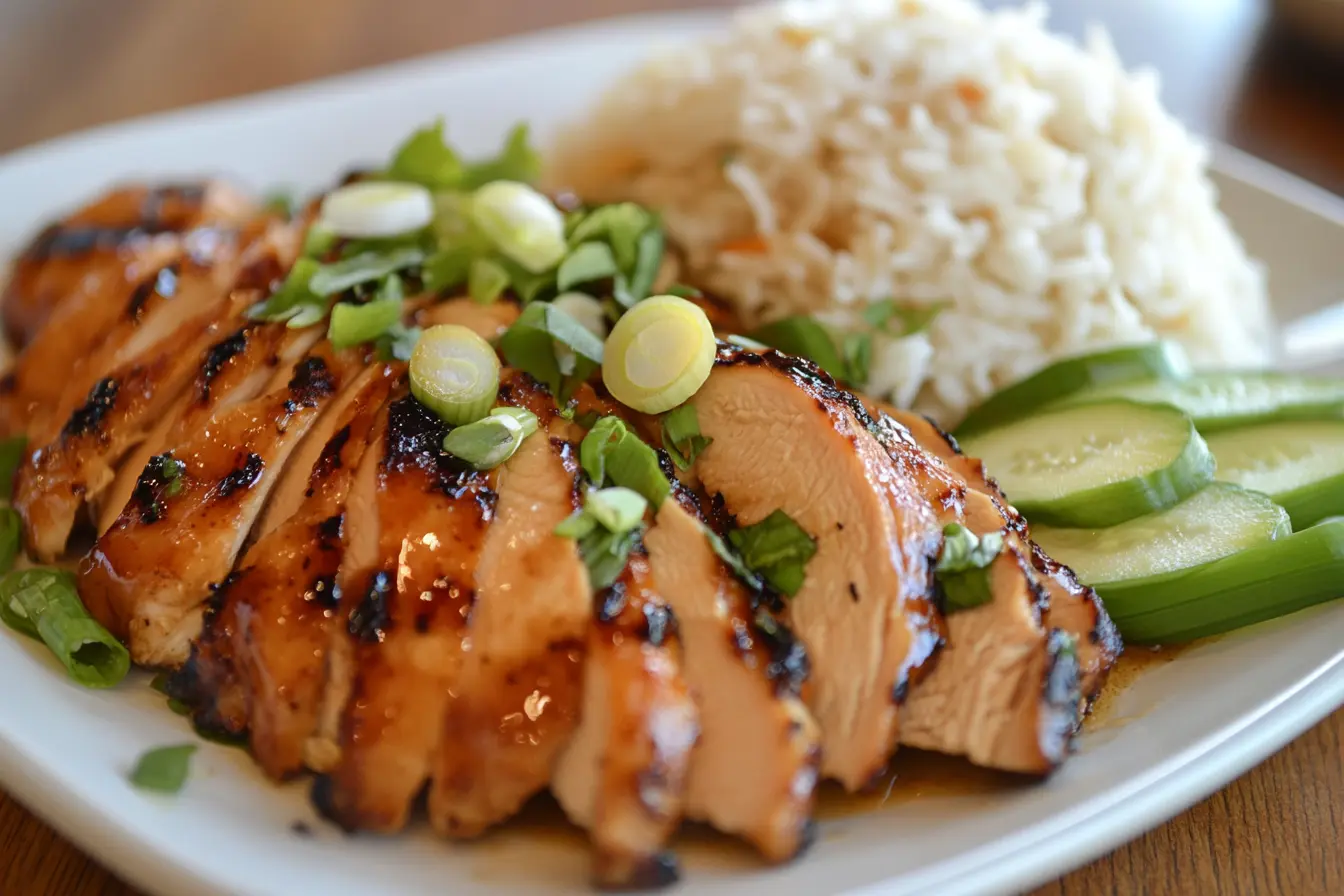Introduction
What Is Ginger Chicken?
Ginger chicken blends tender chicken pieces with the bold, spicy aroma of fresh ginger. Chefs usually cook it with garlic, scallions, and soy sauce to create a dish that is both comforting and full of flavor. The recipe’s balance of sweet, savory, and mildly spicy flavors makes it a favorite at dinner tables everywhere.
This dish adapts easily to different tastes. Some cooks prefer adding vegetables like bell peppers or mushrooms for more texture, while others keep it simple by sticking to just a few ingredients. Despite the variations, one thing remains constant: the vibrant flavor of fresh ginger.
Historical Origins
This dish’s roots lie in ancient Chinese cooking, where ginger served as both a spice and a medicine. Culinary experts in Hunan province were likely the first to pair ginger with chicken, using its natural heat to create flavorful meals.
Over time, ginger chicken spread across Asia. Thai cuisine introduced Gai Pad King, a version of ginger chicken cooked with mushrooms and bell peppers. Indian kitchens added aromatic spices like cumin and turmeric to create rich curries. Although the techniques differ, all versions celebrate ginger as the hero of the dish.
Nutritional Benefits
Ginger chicken doesn’t just taste great—it’s healthy, too! Chicken provides lean protein, which helps build and repair muscles. Ginger, on the other hand, brings a host of benefits. It fights inflammation, boosts digestion, and strengthens immunity.
When you combine these ingredients with garlic and scallions, the dish becomes even more nutritious. Every bite delivers a mix of essential nutrients, perfect for maintaining a healthy and balanced diet.
Core Ingredients
Chicken: The Primary Protein
Chicken is the heart of ginger chicken, and choosing the right cut makes all the difference. Many chefs opt for boneless, skinless thighs because they stay juicy and tender during cooking. Unlike chicken breasts, which can dry out quickly, thighs retain their moisture and absorb the sauce beautifully. However, some recipes use chicken breasts for a leaner option, especially in calorie-conscious variations.
To prepare the chicken, it’s often cut into bite-sized pieces to ensure even cooking and better sauce absorption. Marination, although optional in some recipes, plays a key role in enhancing flavor. A quick soak in ginger, garlic, and soy sauce infuses the chicken with a savory base, ensuring every bite bursts with taste.
No matter the cut, the protein not only contributes to the dish’s texture but also acts as a neutral canvas, letting ginger’s bold flavor shine.
Ginger: The Aromatic Star
Ginger is the ingredient that gives this dish its unique identity. Fresh ginger root, sliced or minced, introduces a warming spice that defines ginger chicken’s flavor profile. Its zesty and slightly peppery notes cut through the richness of the sauce, creating a balanced taste.
This aromatic root does more than flavor the dish; it also has remarkable health benefits. Packed with antioxidants and anti-inflammatory compounds, ginger aids digestion and promotes overall wellness. Its ability to tenderize meat naturally makes it an indispensable component of the recipe.
When preparing ginger chicken, fresh ginger is always preferred over dried or powdered forms. Fresh ginger provides a more robust and nuanced flavor, ensuring the dish remains vibrant and authentic.
Garlic and Scallions: Complementary Aromatics
If ginger is the hero of the dish, garlic and scallions are its loyal sidekicks. These two ingredients add depth and complexity, ensuring the dish doesn’t rely solely on ginger for flavor.
Garlic, with its rich and pungent aroma, brings a savory warmth that complements ginger’s spiciness. It blends seamlessly into the sauce, making each bite irresistibly flavorful. Scallions, also known as green onions, provide a mild, onion-like freshness. Added toward the end of cooking, they offer a hint of brightness, balancing the richness of the dish.
Together, garlic and scallions work in harmony with ginger, creating a trio of aromatics that form the backbone of the dish’s flavor.
Soy Sauce: The Salty Component
Soy sauce is the unsung hero of ginger chicken, bringing a deeply savory umami flavor to the table. Its salty richness balances the sweetness of the ginger and the mild heat from garlic. Typically, light soy sauce is used in recipes to enhance the dish without overpowering the other flavors.
In addition to its flavor, soy sauce contributes to the dish’s appetizing color. Its dark hue coats the chicken, giving the dish a glossy and visually appealing finish. Low-sodium soy sauce is a great alternative for those watching their salt intake.
A good-quality soy sauce elevates the dish, ensuring every component comes together in harmony.
Additional Ingredients
While the core ingredients remain consistent, ginger chicken recipes often feature additional elements that add texture and flavor. Bell peppers, for instance, bring sweetness and crunch, while mushrooms add a savory, earthy note. Onions can be caramelized for sweetness or sautéed for a milder flavor.
Regional recipes sometimes incorporate chili peppers for heat or oyster sauce for added depth. A touch of honey or brown sugar can balance the spiciness, while sesame oil imparts a nutty finish. These ingredients not only enhance the dish but also allow cooks to personalize their ginger chicken, making each version unique.
Preparation Methods
Marination Process
Marination plays a pivotal role in making ginger chicken flavorful and tender. By soaking the chicken in a mixture of fresh ginger, garlic, soy sauce, and seasonings, the flavors penetrate deeply, ensuring every bite is infused with aromatic goodness. This process not only enhances the dish’s taste but also tenderizes the chicken, making it succulent and juicy.
To start, prepare a marinade using minced ginger, crushed garlic, soy sauce, and a touch of sesame oil for richness. Some variations include a hint of honey or brown sugar for sweetness, while others add chili flakes for a spicy kick. Once the marinade is ready, coat the chicken thoroughly and let it rest.
For best results, marinate the chicken for at least 30 minutes. However, allowing it to sit for a few hours or overnight intensifies the flavor even more. This simple yet crucial step elevates the dish from ordinary to extraordinary, ensuring the chicken absorbs every nuance of the seasonings.
Cooking Techniques
Ginger chicken can be prepared using two main methods: stir-frying and braising. Each technique offers a unique texture and flavor profile, giving cooks flexibility based on their preferences.
Stir-frying is a quick, high-heat method ideal for preserving the vibrant flavors of ginger and garlic. In this approach, the marinated chicken is seared in a hot wok or skillet, creating a lightly caramelized exterior while keeping the inside tender. Vegetables like bell peppers or mushrooms can be added during the stir-frying process to enhance the dish’s texture and nutritional value.
Braising, on the other hand, involves cooking the chicken slowly in a flavorful liquid, such as a combination of soy sauce, chicken broth, and additional ginger. This method allows the flavors to meld together, resulting in a deeply savory and aromatic dish. Braising is perfect for those who prefer a saucier version of ginger chicken.
Both methods deliver delicious results, but the choice depends on whether you crave a quick stir-fry or a rich, slow-cooked meal.
Serving Suggestions
Ginger chicken is a versatile dish that pairs beautifully with a variety of sides, making it a complete and satisfying meal. Most commonly, it’s served over steamed jasmine rice, which absorbs the savory sauce and balances the bold flavors. For a heartier option, serve it with egg noodles or rice noodles, tossing them in the sauce to create a cohesive dish.
To round out the meal, consider adding stir-fried vegetables like broccoli, snap peas, or bok choy. The fresh, crisp texture of these greens complements the tender chicken and the warm, spicy notes of ginger. Garnishing the dish with freshly chopped scallions or cilantro adds a burst of color and freshness.
For an extra layer of flavor, sprinkle toasted sesame seeds or a drizzle of sesame oil before serving. Whether you’re hosting a dinner party or preparing a family meal, ginger chicken with thoughtful accompaniments never fails to impress.
Regional Variations
Chinese Ginger Chicken

Chinese ginger chicken embodies simplicity and bold flavors. The dish features tender chicken pieces cooked in a savory, sticky brown sauce, making it an irresistible favorite in Chinese households. Fresh ginger, garlic, soy sauce, and sometimes Shaoxing wine form the base of the sauce, while a touch of sugar balances the saltiness and brings a slight caramelized sweetness.
Cooking typically starts with stir-frying the chicken in a hot wok to lock in moisture, followed by simmering it in the sauce. This technique ensures the chicken remains juicy while absorbing the aromatic flavors. Some variations include additional ingredients like mushrooms or bamboo shoots to enhance texture and variety.
Chinese ginger chicken is traditionally served over fluffy white rice or egg noodles, allowing the sauce to coat every bite. It’s a comforting meal that showcases the harmony of ginger’s sharpness with the umami depth of soy sauce. For authentic recipes, explore resources like Allrecipes.
Thai Ginger Chicken (Gai Pad King)
In Thailand, ginger chicken takes on a vibrant twist as Gai Pad King. This stir-fried delight combines ginger, garlic, onions, and vegetables like bell peppers and mushrooms. Thai chefs often use fish sauce and oyster sauce to season the dish, giving it a deep, savory flavor with a hint of sweetness.
What makes Gai Pad King unique is its balance of textures and flavors. The ginger slices remain slightly firm, providing a zingy crunch, while the vegetables add freshness. Stir-frying the chicken ensures it cooks quickly, keeping it tender and flavorful.
Thai ginger chicken pairs perfectly with jasmine rice, which absorbs the aromatic sauce. For those looking to add spice, Thai chili peppers can be included, creating a fiery version of the dish. To learn more, visit Allrecipes.
Indian Ginger Chicken

Indian ginger chicken is a rich and aromatic dish, reflecting the country’s love for bold spices. Chicken pieces are first marinated in a mixture of fresh ginger, garlic, turmeric, cumin, and coriander. This marinade not only infuses the chicken with flavor but also tenderizes it, ensuring a melt-in-your-mouth texture.
The dish is cooked by sautéing the marinated chicken with onions, tomatoes, and additional spices, creating a flavorful gravy. Some recipes incorporate yogurt to add creaminess, while others keep the sauce lighter by using broth. The result is a warm, spicy, and slightly tangy dish that pairs wonderfully with naan or basmati rice.
Indian ginger chicken showcases the versatility of ginger in a spice-rich context. Its depth of flavor makes it a crowd-pleaser at gatherings or family dinners. For a detailed recipe, check out Meat Chef Tools.
Advancing to the next topic, we’ll address common questions about ginger chicken in the frequently asked questions (FAQs) section.
Frequently Asked Questions
What is ginger chicken made of?
Ginger chicken is made using chicken, fresh ginger, garlic, soy sauce, and scallions as the primary ingredients. Depending on the recipe, additional elements like bell peppers, mushrooms, and onions may be included. Seasonings like fish sauce, oyster sauce, or spices such as cumin and turmeric enhance the flavors in regional variations.
The preparation method usually involves marinating the chicken to infuse it with the flavors of the ginger and garlic. Afterward, the chicken is stir-fried or braised in a savory sauce, creating a delicious meal. This combination of ingredients makes ginger chicken a flavorful and aromatic dish with a balance of spicy, savory, and slightly sweet notes.
How do you make ginger chicken?
To prepare ginger chicken, start by marinating chicken pieces in a mix of ginger, garlic, soy sauce, and optional seasonings like sesame oil or chili flakes. Let the chicken sit for at least 30 minutes to absorb the flavors.
Once marinated, stir-fry the chicken in a hot wok or skillet until it browns slightly. Add vegetables like bell peppers or mushrooms if desired, and pour in a sauce made of soy sauce, chicken broth, and a touch of sugar. Let it simmer until the chicken cooks through and the sauce thickens. Serve hot over rice or noodles for a complete meal.
What does ginger chicken taste like?
Ginger chicken has a well-rounded flavor profile that’s both savory and aromatic. The ginger provides a mild, warming spice that’s complemented by the garlic’s richness. Soy sauce adds a salty umami depth, while optional ingredients like sugar or honey contribute a subtle sweetness.
Depending on regional recipes, the dish can also include spicy, tangy, or earthy notes from added spices or sauces. Overall, ginger chicken is a harmonious blend of bold and balanced flavors, making it appealing to a wide audience.
Is ginger chicken healthy?
Yes, ginger chicken is a healthy dish when prepared with minimal oil and fresh ingredients. Chicken offers lean protein, essential for muscle growth and repair. Ginger, the star ingredient, is rich in antioxidants and anti-inflammatory properties, promoting digestive health and boosting immunity.
The inclusion of vegetables like bell peppers and mushrooms further enhances the dish’s nutritional value, adding fiber, vitamins, and minerals. Opting for low-sodium soy sauce and using less sugar can make the dish even healthier without compromising its taste.
Can I make ginger chicken vegetarian?
Absolutely! To make ginger chicken vegetarian, replace the chicken with tofu, seitan, or tempeh. These plant-based proteins absorb the marinade well, offering a satisfying texture.
Prepare the dish in the same way, stir-frying or braising the tofu with ginger, garlic, soy sauce, and your choice of vegetables. You can also add chickpeas or lentils for extra protein. This vegetarian version retains all the aromatic flavors of ginger chicken while catering to a plant-based diet.
What dishes pair well with ginger chicken?
Ginger chicken pairs beautifully with steamed jasmine rice or egg noodles, which absorb the rich sauce and complement its flavors. For a lighter option, consider serving it alongside stir-fried vegetables like broccoli, snap peas, or bok choy.
Adding fresh salads or pickled vegetables can provide a tangy contrast, enhancing the overall meal. Garnishes such as chopped scallions, sesame seeds, or a drizzle of sesame oil can elevate the dish further, making it suitable for both casual dinners and festive occasions.

